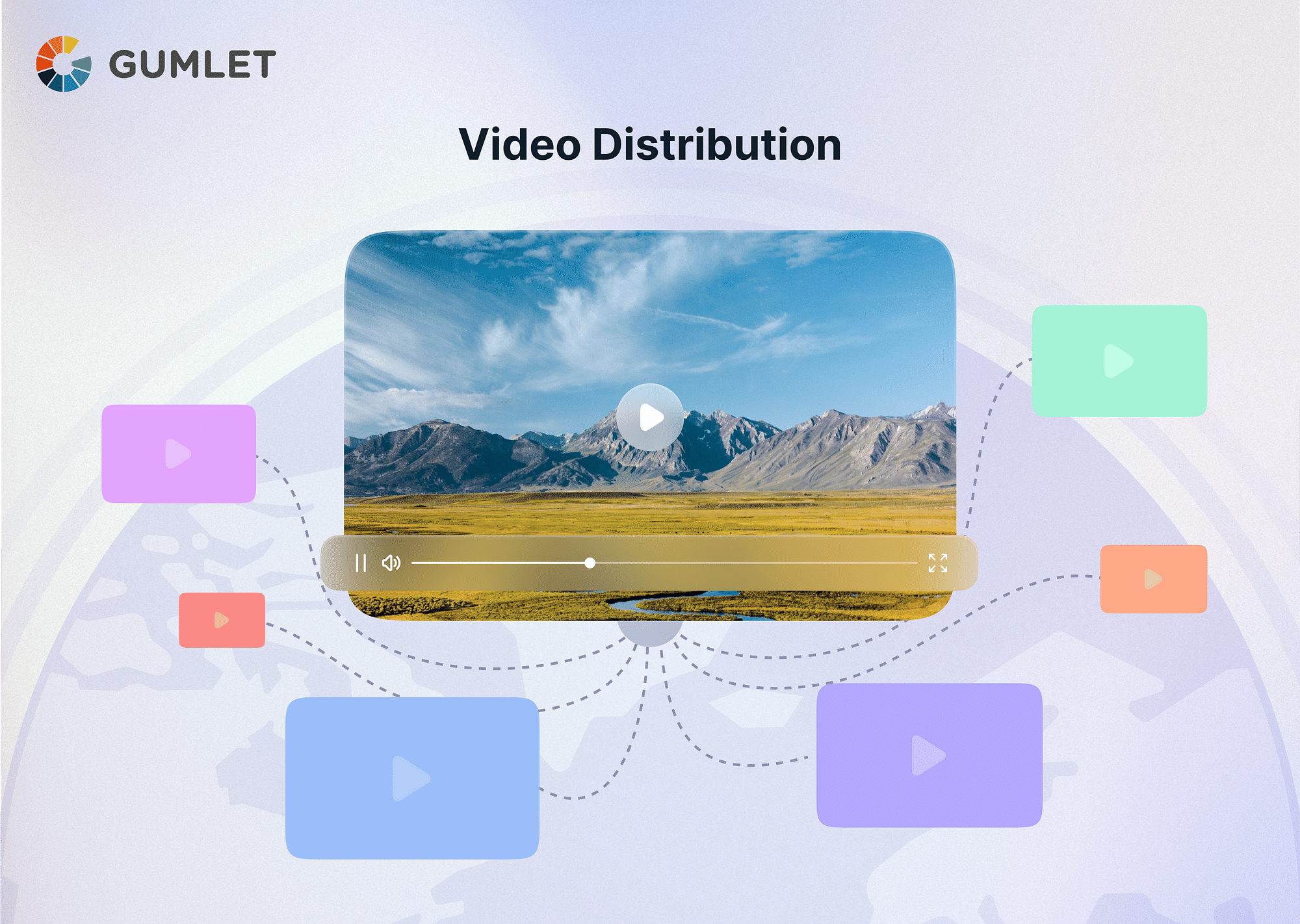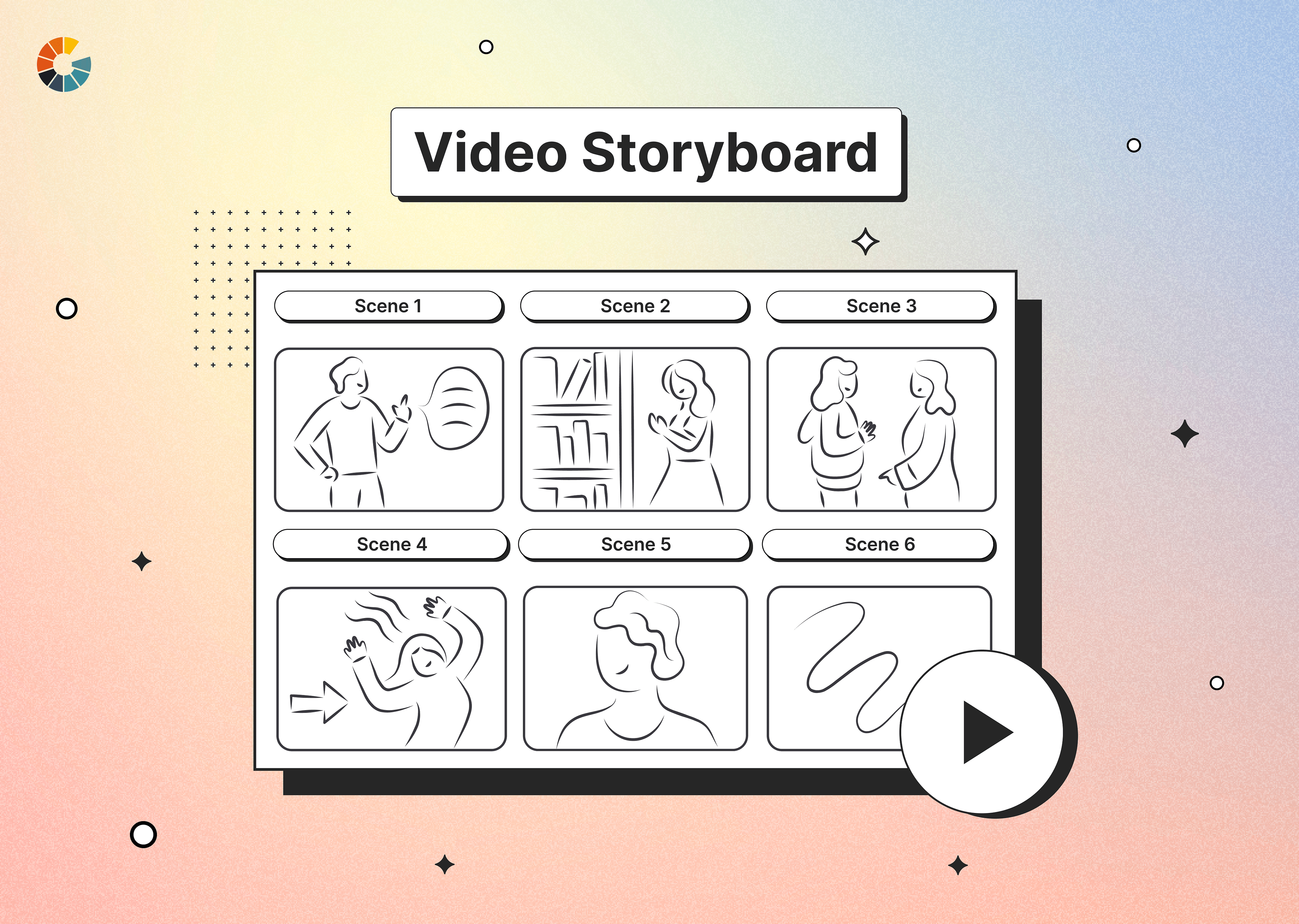Video distribution is not just about sharing content; it's also a strategic form of marketing. Aimlessly distributing videos in areas where your target audience won't find them will waste both time and resources. Therefore, well-structured and effective video distribution strategies are essential. This article will explore the best ways to maximize video reach.
What is Video Distribution?
Video distribution is the most critical aspect of video marketing. It involves the widespread dissemination and sharing of video content to reach the target audience effectively. It encompasses the process of sharing across different video distribution platforms and channels to maximize accessibility, discoverability, and engagement for the intended viewers.
Effective distribution strategies are crucial for monetizing and capitalizing on the power of video as a versatile and compelling medium in today’s digital landscape.
Schedule a Demo with Our Video Expert!
Discover how Gumlet can help you build a cutting-edge video streaming infrastructure.
Why Does Video Distribution Matter for Businesses?
- Effective video distribution can help a business expand its audience reach and connect with more potential customers.
- Widespread video distribution can significantly increase video engagement.
- Sharing media content across various video distribution channels can improve brand visibility and recognition, fostering brand loyalty among audiences.
- Planned sharing of videos across websites and social media platforms can aid the business’s SEO performance.
- Many video distribution channels offer robust analytics to provide valuable insights about audience behavior, preferences, engagement, etc.
Types of Video Distribution Channels
There are many channels that are specifically dedicated to video content distribution. They can be categorized into three types:
Earned Distribution
Earned distribution is the most important out of the three. It involves letting other users share your video content across their own preferred channels. The people who share your content can be influencers, magazines, news websites, or even average users who are retweeting or reposting your video across different social channels.
In all cases, earned distribution occurs when you are not paying anyone to share your content, but they are still doing so willingly.
Examples of earned distribution are:
- Social media shares, retweets, reposts, and recommendations.
- Product reviews.
- Non-sponsored blog posts from third-party websites.
- Organic high-ranking results on various search engines.
Owned Distribution
Owned distribution refers to the practice of distributing your video content on any channel that you own yourself. Unlike in the case of earned distribution, video sharing takes place on third-party platforms and channels. As such, users have total control over this distribution method, allowing them to predict the returns over time.
Examples of owned distribution channels are:
- Your website.
- Your blog.
- Your company’s newsletter.
- Your E-Commerce stores.
- Your social media handles.
Paid Distribution
Paid distribution is when you pay any third-party website or platform to share your video content to maximize reach and engagement. It differs from owned distribution in the sense that you don’t own the platform on which the video is shared. On the other hand, it differs from earned distribution in the sense that the third-party entities are not voluntarily sharing your videos but are obligated to do so because of your payment terms.
Examples of paid distribution channels are:
- Social media advertising, like sponsored posts on Facebook.
- Sponsored content on third-party websites or blogs.
- External advertising tools like Outbrain.
- Advertising on OTT platforms, such as buying ad spots on YouTube or sponsoring content on Hulu.
- Display advertising and paid rankings on search engines.
- Paid appearances on influencers’ channels or platforms.
6 Best Strategies to Distribute Video Content Online
Video content distribution requires proper planning and effective implementation. Developing strategies beforehand is key to ensuring that your video content reaches a maximum number of interested viewers.
Here are some strategies that you can implement to improve your video marketing game.
1. Embedding Videos on your Websites or Blogs
According to a survey, around 53% of internet surfers prefer a landing page that contains at least one video. That is why embedding videos on your websites or blogs is the best way to communicate what your business is all about in an effective and streamlined manner. Doing so will also improve your website’s SEO while indirectly increasing the time people spend on your webpage (an important metric known as dwell time).
Here are some effective tips to keep in mind while embedding videos on your landing page:
- Ensure the video player and website layout are mobile-friendly to increase the overall reach and engagement. Always prefer choosing a template that enhances the usability of your website pages
- Ensure you turn off the auto-play feature to decrease negative user experiences.
- Include CTAs near the video to increase engagement.
- Include transcripts and subtitles to make the video more accessible.
- Add social media share buttons below the video to make it easier for viewers to pass on the video to their preferred platforms.
- Add embed codes so that others can share your video on their own websites.
2. Leveraging Social Media Platforms
Social media platforms offer an expansive audience reach. They can act as one of the strongest video marketing channels and effective distribution. Each platform, like Facebook, Instagram, TikTok, and LinkedIn, has native video hosting capabilities that allow users to upload and share videos directly with their followers. Leveraging the power of social media platforms for video content distribution can significantly improve the overall reach while also fostering community engagement.
Here are some effective tips to make the best of social media platforms:
- Tailor your video specs according to the individual requirements of each social media platform, like aspect ratios, video length, and resolution.
- Add subtitles and captions to your videos, as many social media users watch videos without turning the sound on.
- Upload videos natively on major platforms like Facebook and Instagram instead of sharing external links.
- Use relevant hashtags and keywords to make your videos more discoverable.
3. Using Video Hosting Platforms
Video hosting platforms like YouTube and DailyMotion allow you to reach a broader audience beyond your website or social media handle. They often provide features like built-in search functionalities and social sharing options, making your videos more discoverable and shareable.
Here are some effective tips for using video hosting platforms for effective video content distribution:
- Choose the right platform that aligns with your goals and target audience.
- Categorize your videos appropriately and add relevant tags to make them more searchable within the platform.
- Customize the video player according to your own brand to increase business visibility and recognition.
- Include transcriptions and subtitles.
Gumlet will help you do all this and more. Check it out today!
4. E-mail Marketing
Integrating the use of video content into your personalized email marketing campaigns can help improve engagement and click-through rates. You can easily include video thumbnails or GIFs in your emails to pique and capture recipients' interest and encourage them to watch the full video. Make sure that you personalize the messages, segment your email lists, and use compelling subject lines to boost open rates. You can choose an email newsletter software that is easy to use, and offers many engaging templates to keep your audience hooked.
Here are some more effective tips on how to use email marketing as a video distribution channel:
- Segment your email lists based on interests, preferences, and demographics to send targeted video content.
- Include thumbnails or GIF previews to make your mail content more attention-grabbing.
- Use CTAs in your email to encourage readers to interact with the video.
- Design your email template in a mobile-friendly format, take help of an email template builder.
- Send follow-up emails to increase the likelihood of engagement or any response.
5. Search and Social Media Ads
Using paid advertising strategies on search engines and social media platforms can effectively distribute your video content to the targeted audience.
Various platforms like Google Ads offer the option to run video ads, reaching users based on their intent and interests.
Here are some effective tips to maximize your video distribution reach using search and social media ads:
- Conduct thorough keyword research to ensure your ads reach the right audience.
- Create compelling ad copy to communicate your message effectively.
- Direct users to dedicated and relevant landing pages.
- Use ad extensions like site links or callouts to provide additional information and increase visibility.
6. Collaborating with Influencers or Partners
Partnering with influencers and industry-related content creators can increase your video’s reach substantially. Influencers can create sponsored content or collaborate on joint video projects to divert their significant following to your business. Ensure you choose influencers who align with your brand values and share a similar target audience to ensure maximum relevance and impact.
Here are some tips for using influencers to maximize the impact of your video distribution strategies:
- Consider pairing up with micro-influencers, who have smaller but highly niche-specific audiences, for a more targeted video distribution effort.
- To ensure maximum participation, keep the partners and influencers in the loop during the planning and creation process.
- Use cross-promotion across various social media platforms and channels to maximize reach.
- Use unique tracking links and tools to track performance and measure the impact of influencer-driven video distribution.
- Measure ROI from influencer collaborations to determine the effectiveness of video distribution and inform future partnerships.
How to Measure the Success of Distributed Videos?
Simply distributing your video across different channels isn’t enough. You also have to ensure that your video marketing strategies are working effectively.
Fortunately, there are many key performance indicators (KPIs) and metrics that can be used to measure the success of distributed videos.
Important Metrics for Measuring Video Distribution Effectiveness
- View Count: The most straightforward metric to measure the success of distributed video is the view count. While higher view counts are definitely indicators of a successful performance, some other metrics need to be considered.
- Watch Time: This is the total amount of time viewers spend watching a specific video. Longer watch times indicate that the video content is engaging and interesting for the viewers.
- Engagement Metrics: Engagement metrics, such as likes, comments, shares, and click-through rates, offer valuable insights into how the audience is responding to the distributed video.
- Conversion Rates: For videos containing CTAs, tracking conversion rates is essential to help determine the effectiveness of the video’s impact on actual business objectives and ROI.
- Referral Traffic: Referral traffic from various platforms to your website or blog can tell you how effective the video is at driving users out of the primary source to explore more of your content and offerings.
Using Video Hosting Platforms for Improved Video Analysis
Major hosting platforms come with built-in analytics tools to help users track the success of distributed videos. Leveraging these platforms beyond their basic function of hosting and sharing videos should be a big part of your video marketing strategy.
Gumlet, one of the most popular and powerful hosting platforms, provides engagement metrics, latency metrics, and other analytics to understand better various factors that may be affecting the success or failure of video distribution strategies. You would get a comprehensive report of total views, unique users, and playback time and include playback failures, player load delays, bandwidth wastage, device or browser errors, etc., to elevate your video experience. Start monitoring your video insights with Gumlet's free trial now.
Best Video Distribution Platforms
There are many platforms and channels that you can leverage for efficient video distribution. Some of them are as follows:
Social Media Platforms
- Facebook: Facebook offers an extensive user base, which makes it an ideal platform to share your videos, reach a wider demographic and drive meaningful engagement with your audience. You can share your videos on the platform and connect with viewers dynamically and interactively.
- Twitch: Twitch is widely popular for live streaming and gaming—which provides enthusiasts an opportunity to connect with an active and passionate community. Whether live streaming gameplay or other niche content, you can participate in real-time interactions with viewers to help build a dedicated following.
- Instagram: Instagram is perfect for sharing short, engaging, and appealing video clips. You can leverage features like Reels, Stories, and IGTV to keep your audience captivated, share your story, and drive meaningful interactions that keep viewers coming back for more.
Video Hosting Platforms
- YouTube: YouTube is the oldest and the most popular video-sharing and hosting platform. Users can upload, watch, and share videos on this platform on a daily basis. YouTube’s impressive user base as well as adequate search functionalities, make it a good platform for distributing your video efficiently.
- DailyMotion: DailyMotion is known for its basic interface, simplicity, and lack of regulations. You can upload virtually any type of video content on this hosting platform. While its functionalities and features are limited compared to YouTube and Gumlet, it offers a large user base for increasing the overall reach and engagement of your videos.
- Gumlet: Gumlet is a powerful hosting platform and has a rapidly growing user base, making it a great option for people looking to expand their viewership. Gumlet offers many advantages such as easy transcoding, buffer-free streaming, and new-age, robust analytics support. It can serve as an integral part of a content creator’s video marketing strategy and aid in the quest to improve reach and engagement.
Conclusion
Video distribution is an integral component of video marketing. Without any proper strategy, content creators are bound to waste a lot of time and energy distributing their videos where the results are not guaranteed.
By leveraging important video distribution channels and other insights, you can maximize your return on investment and maximize your video’s growth potential.
Frequently Asked Questions (FAQs)
1. Which distribution channels help drive new channels?
Distribution channels that offer significant returns, like social media platforms, influencer collaborations, and paid advertising, can help drive new channels by expanding reach, attracting new audiences, and increasing visibility.
2. How do I optimize videos for different platforms before distribution?
You can optimize videos according to the requirements and specifications of different platforms by adjusting the formats, resolution, and aspect ratios accordingly. Customizing titles, descriptions, and thumbnails according to each platform's user base can also be effective. Tools like Gumlet can help with this process by allowing users to build their own video pipelines for optimal results.




